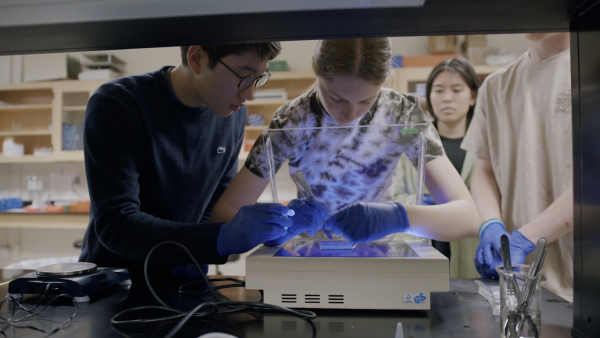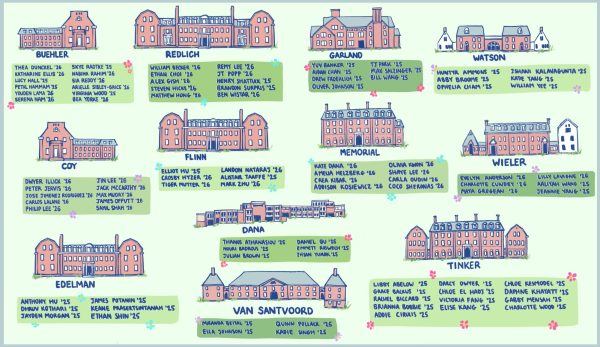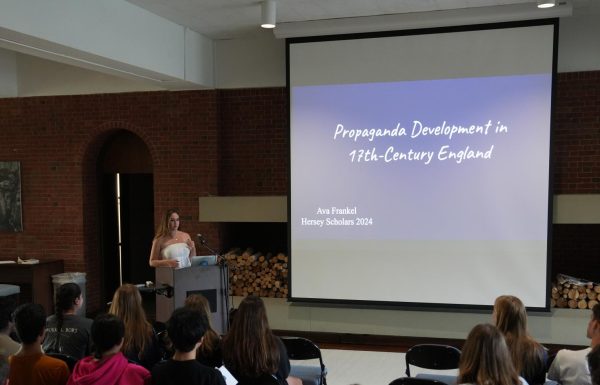Moving Towards A Carbon-Neutral Campus
Since the early 2000s, the school has committed itself to sustainability by pursuing renewable energy. Mr. Josh Hahn, director of strategic initiatives and associate head of school, said, “Environmental stewardship has always been an important aspect of the school, but in recent times, we have really made some meaningful decisions…around demonstrating that value institutionally.”
The school has been a leader in the green building movement, with multiple Leadership in Energy and Environmental Design (LEED) certified buildings (the Biomass Facility, Edelman, Elfers, Flinn, and Monahan) on campus.
Currently, the main sources of renewable energy on campus are the Biomass Plant and solar panels on the ’49 fields and at Fairfield Farm. Referencing numbers provided by energy consulting firm Stone House Group and calculated by non-profit Clean Air Cool Planet’s software, Mr. Hahn said, “The biomass plant produces 95% of the school’s heat and hot water during the period of November 1 to April 1, which consists of 40% of the school’s overall carbon footprint. The solar array at the Grange creates enough electricity to run the [Fairfield] Farm buildings, and the solar array on the ’49 fields creates enough electricity to offset at least 33% of the MAC’s electricity.”
The biomass facility uses locally-sourced wood chips, instead of oil. This move away from fossil fuels saves the school an average of $600,000 annually and cuts its carbon footprint by about 40% (compared with when the school used oil). The wood chips replace 150,000 gallons of fuel per year. By purchasing wood chips locally, the biomass facility also infuses money into the local economy, which gives back to our community.
The smaller solar array on the roof of the Grange building at the Farm provides power to the Grange and the Barnhouse. A website used to monitor the energy production of that solar array in live time shows that the array’s production of solar energy has prevented 128,593.05 lbs of carbon dioxide emissions, which is equivalent to planting 3,239 trees. In the future, Mr. John Bryant, director of facilities, predicts that solar power will play an expanded role in the coming years, and the use of electrical vehicles and equipment by the school will also increase. Also, 35% of electricity comes from wind power, which the school purchases from off-campus sources.
The school also focuses on energy efficiency when designing or installing new mechanical and HVAC systems. As Mr. Bryant said, “[The school] uses the waste heat from all of the refrigeration equipment in the Dining Hall and kitchen to pre-heat incoming water, so that generation of domestic hot water is much more efficient.”
The school has a goal of carbon neutrality by 2020 and has made green infrastructure and energy efficiency a priority in recent construction. While building square footage has increased by one-third in the past few years, overall energy use on campus has decreased by almost 20%. Mr. Hahn said, “[We] have been excellent at decreasing our emissions in many respects, [and] we have done so in the midst of a 10% increase in electricity use due to a number of factors, the primary driver [being] the increase [in the number of] air conditioned spaces on campus.”
On the topic of student involvement, Mr. Hahn said, “Students are involved in various ways already, but there is always room for more. Students can talk to the Students for Environmental Awareness (SEA) and ask their teachers to incorporate [environmental] projects into their lessons more frequently as a start.”
Indeed, our day-to-day behaviors can make a huge difference. Mr. Bryant believes that the greenest energy is energy not used. Thus, the best way everyone can help is to be more aware of the energy they are using by doing simple things such as shutting off the lights when leaving a room or unplugging chargers when they are not in use.
Mr. Hahn is focusing on reducing food waste this year. He said, “As a school, we can save some money and be better stewards of our resources if we cut down on how much food we dump into that bin in the Dining Hall.”
For the school to reach its goal of carbon neutrality, students must ultimately initiate the change, as we are the primary consumers of the majority of the school’s resources.













